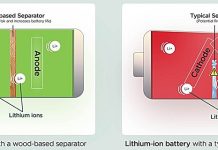
The rising demand for lithium-ion batteries in electric cars, computers, and portable devices has led to an increase in the price of lithium, turning it into a sought-after resource.
To address this challenge and ensure a stable supply, scientists are exploring alternatives to lithium.
Recently, researchers from Arizona State University have made progress by experimenting with a combination of lithium and sodium in batteries.
This approach promises to reduce costs, secure the supply chain, and pave the way for more affordable and accessible batteries.
Sodium, which is found abundantly in seawater as sodium chloride, is cheaper and more readily available compared to lithium.
While sodium-based batteries have their limitations, lithium batteries remain the preferred choice for delivering the concentrated charge required to power cars and portable devices.
The innovative approach taken by Ph.D. student Tullio Geraci and Professor Alexandra Navrotsky involves blending small amounts of sodium with lithium in the same battery, leveraging the benefits of both elements.
The research team focuses on creating lithium-sodium materials and assessing their structures, uniformity, and thermodynamic properties.
They employ a specialized technique called High-Temperature Oxide Melt Solution Calorimetry to measure the energetic stability of the materials. Through heating experiments, they investigate the possible decomposition of the materials during use.
Presenting their findings at the Goldschmidt geochemistry conference, Tullio Geraci explained that they initially tested mixtures of lithium and sodium for stability.
While early attempts showed limited promise, stability improved as they increased the sodium content. So far, they have achieved a 10% mixture of sodium and lithium, which remains thermodynamically stable. The researchers believe they can push the ratio up to around 20% without significant performance differences.
Once they determine the optimal mix, the research team plans to collaborate with battery technologists to develop the first sodium-lithium batteries.
This is a critical step in the advancement of this new battery technology. The ultimate goal is to create batteries that are not only cost-effective but also sustainable, meeting the increasing demand for energy storage in our daily lives.
Professor Nancy Ross from Virginia Tech, who provided an independent comment, emphasized the significance of this research. She highlighted how the application of geochemistry in developing new materials can lead to alternative, affordable, and sustainable sources for lithium batteries.
The work by Geraci and Navrotsky holds promise for exploring innovative avenues in battery technology, benefitting society as a whole.
The collaboration between scientists at Arizona State University has opened up a new frontier in battery development. By combining sodium and lithium in the same battery, they aim to create a cost-effective and reliable solution that can meet the growing demand for energy storage.
While still in the developmental stage, this research represents a significant step toward more accessible and sustainable battery technologies.
In the future, this breakthrough could make powerful batteries more affordable, revolutionizing the way we power our devices and contributing to a greener and more efficient world.
Follow us on Twitter for more articles about this topic.
Source: Goldschmidt Conference.



